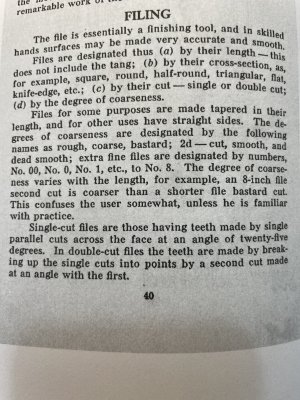I've found an answer:
"Example: At a length of 250 mm, a cut 1 file has 9 teeth/1 cm of file length. A 100 mm long cut 1 file has 17 teeth/1 cm of file length, however. The higher number of teeth on shorter files ensures the same ease of use (in terms of force input, guidability and stock removal rate) on surfaces and edges as for longer files."
From: https://us.pferd.com/en/knowledge/tools/most-important-basics-files/
So this explains why my small files are listed as a Bastard cut.
Now I just need to develop a list of the files I want to order!
"Example: At a length of 250 mm, a cut 1 file has 9 teeth/1 cm of file length. A 100 mm long cut 1 file has 17 teeth/1 cm of file length, however. The higher number of teeth on shorter files ensures the same ease of use (in terms of force input, guidability and stock removal rate) on surfaces and edges as for longer files."
From: https://us.pferd.com/en/knowledge/tools/most-important-basics-files/
So this explains why my small files are listed as a Bastard cut.
Now I just need to develop a list of the files I want to order!

